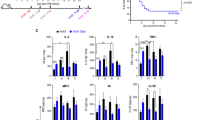Abstract
Yersinia pestis is a gram-negative bacillus that can cause pneumonia if inhaled. Secondary person-to-person spread of infection can develop. Aerosolization of this organism as a weapon of biological terror could potentially cause many thousands of casualties, mass social disruption, and widespread fear. Plague pneumonia is treatable if recognized early but still carries a 50% to 60% mortality rate. Delay in therapy is associated with 100% mortality rates. Prophylaxis of exposed persons with oral antibiotics is indicated. There is no protective vaccine currently available.
Similar content being viewed by others
References and Recommended Reading
Butler T: Yersinia infections: ventennial of the discovery of the plague bacillus. Clin Infect Dis 1994, 19:655–663.
Cleri DJ, Vernaleo JR, Lombardi LJ, et al.: Plague pneumonia: Disease caused by Yersinia pestis. Seminar Respir Infect 1997, 12:12–23.
Centers for Disease Control and Prevention: Human plague - India 1994. Morbid Mortal Wkly Rprt 1994, 43:689–691.
Barnes AM: Surveillance and control of bubonic plague in the United States. Symp Zool Soc Lond 1982, 50:237–270.
Welty TK, Grabman J, Kompare A, et al.: Nineteen cases of plague in Arizona - A spectrum including ecthyma gangrenosa due to plague and plague in pregnancy. West J Med 1985, 142:641–646.
Myer K: Pneumonic plague. Bacteriol Rev 1961, 25:249–261.
Centers for Disease Control and Prevention: Public health emergency preparedness and response. Accessible at http:// www.bt.cdc.gov. A continuously updated website providing epidemiologic and treatment information regarding bioterrorism issues, threats, and actual occurences.
Inglesby TV, Dennis DT, Henderson DA, et al.: Plague as a biological weapon: medical and public health management. JAMA 2000, 283:2281–2291. An encyclopedic and authoritative review of the use of plague as a biological weapon.
US Army Medical Research Institute of Infectious Diseases: Medical Management of Biological Casualties, edn 3. Fort Detrick, MD; 1998:40–43. An excellent pocket-sized book written in a clear, matter-of-fact style regarding the diagnosis and managemnet of biological weapons casualties.
Relman DA, Olson JE: Bioterrorism preparedness: what practitioners need to know. Infect Med 2001, 18:497–514. An up-to-date, practical review of bioterrorism agents, both clinical manifestations and management.
Health Aspects of Chemical and Biological Weapons. Geneva, Switzerland: World Health Organization; 1970:98-109.
Centers for Disease Control and Prevention: Fatal human plague - Arizona and Colorado, 1996. Morbid Mortal Wkly Rprt 1997, 46:617–620.
Swartz MN: Recognition and management of anthrax - An update. N Engl J Med 2001, 345:1621–1626.
Jefferson T, Demicheli V, Pratt M: Vaccines for preventing plague (Cochrane review). In The Cochrane Library, Issue 2. Oxford: Update Software; 2001. A detailed analysis of the available data regarding plague vaccine effectiveness.
Inglesby TV, Grossman R, O’Toole T: A plague on your city: Observations from TOPOFF. Clin Infect Dis 2001, 32:436–445. A narrative of the TOPOFF exercise that describes the potential scope of a plague attack as well as the problems the state authorities, federal government, and local health care system had in responding to it effectively in a prompt, coordinated manner.
Author information
Authors and Affiliations
Rights and permissions
About this article
Cite this article
Gradon, J.D. Plague pneumonia. Curr Infect Dis Rep 4, 244–248 (2002). https://doi.org/10.1007/s11908-002-0087-y
Issue Date:
DOI: https://doi.org/10.1007/s11908-002-0087-y




